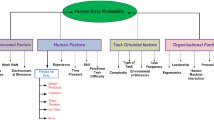Abstract
Westinghouse Electric Company is in the process of completing the Generic Design Assessment (GDA) phase of licensing its AP1000® (®AP1000 is a trademark or registered trademark of Westinghouse Electric Company LLC, its affiliates and/or its subsidiaries in the United States of America and may be registered in other countries throughout the world. All rights reserved. Unauthorized use is strictly prohibited. Other names may be trademarks of their respective owners.) Pressurized Water Reactor (PWR) nuclear power plant in the United Kingdom. To address a Human Factors (HF) GDA issue identified in an earlier phase of the GDA process, the Westinghouse HF team updated the human error analysis methodology to comport with lessons learned and advancements in the field of human reliability analysis (HRA). NUREG-2114 [1] provided a cognitive framework as an update to the psychological basis for HRA, but did not provide specific guidance to analysts on how to use this framework in performing HRA. This paper describes how the Westinghouse HF team adapted the cognitive framework in NUREG-2114 for application in the human error analyses performed to resolve the HF GDA issue. Westinghouse HF determined that the adapted cognitive framework was useful for identifying potential human errors in the task analysis and identifying potential design improvements. Results from using NUREG-2114 to inform human error analysis and recommendations for additional development are discussed.
Access this chapter
Tax calculation will be finalised at checkout
Purchases are for personal use only
Similar content being viewed by others
Notes
- 1.
The Westinghouse process for conducting HRA in the UK involves the Human Factors organization performing the qualitative analysis, and the Probabilistic Risk Analysis (PRA) discipline performing the HRA quantification and input into the overall Probabilistic Safety Assessment (PSA) model. For this reason, Westinghouse uses the term HEA to refer to the qualitative portion of the human reliability analysis.
References
Whaley, A.M., Xing, J., Boring, R.L., Hendrickson, S.M.L., Joe, J.C., LeBlanc, K.L., Morrow, S.L.: Cognitive Basis for Human Reliability Analysis (NUREG-2114). U.S. Nuclear Regulatory Commission, Washington DC (2016)
Office for Nuclear Regulation: Guideline on the Demonstration of ALARP (As Low As Reasonably Practicable). ONR Technical Assessment Guide NS-TAST-GD-005, Rev. 7 (2015)
Office for Nuclear Regulation: Safety Assessment Principles (SAPs). http://www.onr.org.uk/saps/
Forester, J., Dang, V.N., Bye, A., Lois, E., Massaiu, S., Borberg, H., Braarud, P.Ø., Boring, R., Mannisto, I., Liau, H., Julius, J., Parry, G., Nelson, P: The International HRA Empirical Study: Lessons Learned from Comparing HRA Methods Predictions to HAMMLAB Simulator Data (NUREG-2127). U.S. Nuclear Regulatory Commission, Washington DC (2014)
Lois, E., Dang, V.N., Forester, J., Borberg, H., Massaiu, S., Hildebrandt, M., Braarud, P.Ø., Parry, G., Julius, J., Boring, R., Mannisto, I., Bye, A.: International HRA Empirical Study – Phase 1 Report: Description of Overall Approach and Pilot Phase Results from Comparing HRA Methods to Simulator Performance Data (NUREG/IA-0216, vol. 1). U.S. Nuclear Regulatory Commission, Washington DC (2009)
Bye, A., Lois, E., Dang, V.N., Parry, G., Forester, J., Massaiu, S., Boring, R., Braarud, P.Ø., Broberg, H., Julius, J., Mannisto, I., Nelson, P.: International HRA Empirical Study – Phase 2 Report: Results from Comparing HRA Method Predictions to Simulator Data from SGTR Scenarios (NUREG/IA-0216, vol. 2). U.S. Nuclear Regulatory Commission, Washington DC (2011)
Forester, J., Liau, H., Dang, V.N., Bye, A., Lois, E., Presley, M., Marble, J., Nowell, R., Broberg, H., Hildenbrandt, M., Hallbert, B., Morgan, T.: The U.S. HRA Empirical Study – Assessment of HRA Method Predictions against Operating Crew Performance on a U.S. Nuclear Power Plant Simulator (NUREG-2156). U.S. Nuclear Regulatory Commission, Washington DC (2016)
Kolaczkowski, A., Forester, J., Lois, E., Cooper, S.: Good Practices for Implementing Human Reliability Analysis (NUREG-1792). U.S. Nuclear Regulatory Commission, Washington DC (2005)
Health and Safety Executive: Development of a Working Model of How Human Factors, Safety Management Systems, and Wider Organisational Issues Fit Together (RR543). (2007)
Author information
Authors and Affiliations
Corresponding author
Editor information
Editors and Affiliations
Rights and permissions
Copyright information
© 2018 Springer International Publishing AG
About this paper
Cite this paper
Whaley, A.M. (2018). Adapting the Cognitive Framework of NUREG-2114 for Use in Human Error Analysis for AP1000 Plant Licensing in the United Kingdom. In: Boring, R. (eds) Advances in Human Error, Reliability, Resilience, and Performance. AHFE 2017. Advances in Intelligent Systems and Computing, vol 589. Springer, Cham. https://doi.org/10.1007/978-3-319-60645-3_29
Download citation
DOI: https://doi.org/10.1007/978-3-319-60645-3_29
Published:
Publisher Name: Springer, Cham
Print ISBN: 978-3-319-60644-6
Online ISBN: 978-3-319-60645-3
eBook Packages: EngineeringEngineering (R0)




